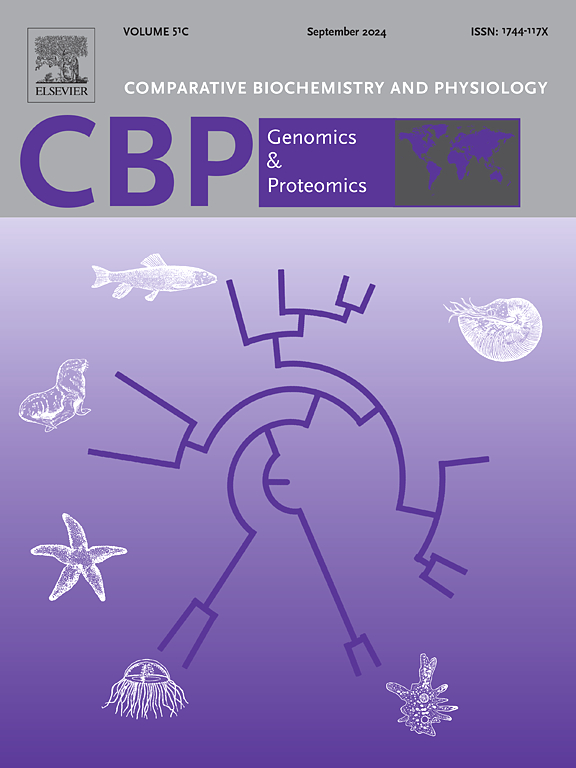比较转录组分析揭示了肾脏对慢性盐胁迫的分子反应
IF 2.2
2区 生物学
Q4 BIOCHEMISTRY & MOLECULAR BIOLOGY
Comparative Biochemistry and Physiology D-Genomics & Proteomics
Pub Date : 2025-06-22
DOI:10.1016/j.cbd.2025.101572
引用次数: 0
摘要
盐度是一个重要的环境因素,超过鱼类渗透调节能力的盐碱水平波动可能对硬骨鱼的各种生理功能产生深远的影响。由于其快速生长和优良的肉质,大琥珀在商业上具有很高的价值。本研究在最佳盐度(30 ppt)、低盐度(20 ppt)和高盐度(40 ppt)条件下饲养大琥珀幼鱼30天。组织学上,慢性盐胁迫下肾脏结构受损,表现为肾小管柱状上皮细胞边缘肥大,中央侧收紧。通过对肾脏的比较转录组分析,分别在K20与K30(686上调,417下调)、K40与K30(14上调,37下调)、K20与K40(1170上调,541下调)盐胁迫组中鉴定出1103、51和1711个差异表达基因(deg)。通过肾转录组分析发现,在盐度胁迫下,细胞骨架(LOC111217621、tubb5和LOC111234965)和细胞凋亡(tnfrsfa、LOC111218420、LOC111223891、LOC111223286和bcl2)中富集了一些基因。此外,还鉴定了与脂质和碳水化合物代谢(elovl61、acsl4、msmo1、pck1、g6pc1、pfkfb3和ldha)、离子转运(kcnk5、slc4a4、slc9a3、slc41a1和slc22a2)和免疫应答(nfkbiaa、nfkbia和LOC111231462)相关的DEGs。这些发现表明,细胞骨架受损,离子转运、脂质和碳水化合物代谢以及对盐度胁迫的免疫反应也发生了变化。本研究结果加深了我们对大琥珀对盐度胁迫的生理反应的理解,这可能有助于制定策略来优化该物种在波动盐度模式环境中的养殖和人工育种。本文章由计算机程序翻译,如有差异,请以英文原文为准。

Comparative transcriptome analysis of juvenile greater amberjack (Seriola dumerili) revealed the molecular responses of the kidney to chronic salinity stress
Salinity is an important environmental factor, and fluctuations in saline-alkali levels that exceed the osmoregulatory capacity of fish may have profound effects on various physiological functions of teleosts. The greater amberjack is highly valued commercially owing to its rapid growth and excellent meat quality. In this study, the juvenile greater amberjack were reared for 30 days under optimal salinity (30 ppt) as well as hypo- (20 ppt) and hyper-salinity (40 ppt) conditions. Histologically, the structure of the kidney was damaged under chronic salinity stress, characterized by hypertrophy at the edges of the columnar epithelial cells in the renal tubules, while the central side was tightened. Through comparative transcriptome analysis of the kidney, a total of 1103, 51, and 1711 differentially expressed genes (DEGs) were identified in the K20 vs. K30 (686 up- and 417 down-regulated), K40 vs. K30 (14 up- and 37 down-regulated), and K20 vs. K40 (1170 up- and 541 down-regulated) salinity stress groups, respectively. Certain DEGs enriched in the cell cytoskeleton (LOC111217621, tubb5, and LOC111234965) and cell apoptosis (tnfrsfa, LOC111218420, LOC111223891, LOC111223286, and bcl2) were identified by kidney transcriptome analysis in response to salinity stress. Furthermore, DEGs associated with lipid and carbohydrate metabolism (elovl6l, acsl4, msmo1, pck1, g6pc1, pfkfb3, and ldha), ion transport (kcnk5, slc4a4, slc9a3, slc41a1, and slc22a2), and immune response (nfkbiaa, nfkbia, and LOC111231462) were identified. These findings suggest that the cytoskeleton was damaged, along with variations in ion transport, lipid and carbohydrate metabolism, and immune responses to salinity stress. The current findings enhance our understanding of the physiological responses of greater amberjack to salinity stress, which could be beneficial in developing strategies to optimize the aquaculture and artificial breeding of this species in environments characterized by fluctuating salinity patterns.
求助全文
通过发布文献求助,成功后即可免费获取论文全文。
去求助
来源期刊
CiteScore
5.10
自引率
3.30%
发文量
69
审稿时长
33 days
期刊介绍:
Comparative Biochemistry & Physiology (CBP) publishes papers in comparative, environmental and evolutionary physiology.
Part D: Genomics and Proteomics (CBPD), focuses on “omics” approaches to physiology, including comparative and functional genomics, metagenomics, transcriptomics, proteomics, metabolomics, and lipidomics. Most studies employ “omics” and/or system biology to test specific hypotheses about molecular and biochemical mechanisms underlying physiological responses to the environment. We encourage papers that address fundamental questions in comparative physiology and biochemistry rather than studies with a focus that is purely technical, methodological or descriptive in nature.

 求助内容:
求助内容: 应助结果提醒方式:
应助结果提醒方式:


